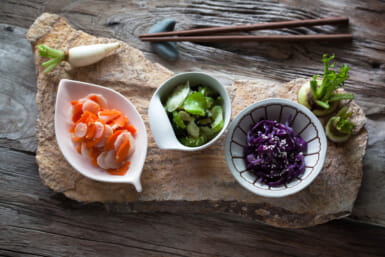with Elizabeth Andoh
(This column completes the recipe for Gomoku Zushi, which appeared in Suki-Yacking July 19, ’74. —Ed.)
SUBASU (marinated lotus root—a side dish)
ingredients:
- 1 lotus root, about 2 inches in diameter, 4-5 inches long; vinegar and cold water for “vinegar baths”
- amazu: 1/3 cup vinegar; 3 1/2 – 4 tablespoons sugar; 1/4 teaspoon salt
instructions:
1. In a bowl, make a vinegar bath of several cups cold water mixed with several tablespoons vinegar.
2. Peel lotus root with a vegetable peeler and immediately immerse in vinegar bath. Leave in “bath” for a minute then rinse under cold running water.
3. Slice as thinly as possible with slightly sawing motions as lotus root is rather hard. Put slices in vinegar bath immediately and let the them soak for at least 3-4 minutes (or until the bath water is no longer very cold). All of these baths and precautions are to preserve the white color and to rid the vegetable of any bitterness.
4. Make amazu by combining ingredients in a small saucepan and heating until sugar is dissolved. Let cool.
5. Make a small vinegar bath in a saucepan and bring it to a rapid boil. Add drained (from first bath) lotus root slices and boil for 1-2 minutes. Don’t overcook; the slices should be crisp.
6. Drain, strain, rinse under cold water and strain again.
7. Marinate the cooked lotus root slices in amazu to cover. Marinate at least 30 minutes and up to 2 days (refrigerated, covered). Remove from marinade before serving.
notes:
1. Hasu or Renkon (both words are used)—lotus root the “h” sound of hasu becomes a “b” when proceeded by “su” (su is “vinegar”)
2. amazu is sweet and sour sauce or dressing
TAMAGO YAKI
If you’re a crepe maker, you’ll have no problems. If you’re not a crepe maker, here’s a list of do’s and don’t’s that might help you in your practice sessions:
1. Don’t use a teflon pan, or a glass or ceramic pan. Do use copper, heavy aluminum or other sturdy metal pan.
2. Don’t use a very large pan; just large enough to hold one egg at a time. Round or square shaped is fine, though traditionally rectangular pans are used in Japan.
3. Do only one egg at a time. Break egg into a small bowl, beat in 1 teaspoon ungranulated sugar. Prepare the pan by pre-heating it over medium heat. Add a drop or two of oil (the pan should be well seasoned by previous use — if not, you’ll have to season it by many heated oilings at regular intervals). Spread the oil evenly with the help of paper towel or gauze. The oil should not smoke.
5. Pour in the egg, after removing pan from direct heat (but keep the flame on medium high), and swish it around to form a thin even layer. Place over direct heat again. Low or uneven heat will cause the yellow to pale in color and will cause sticking and scorching, too. Adjust heat by moving the pan away or near the flame—not by turning the flame high or low.
6. Cook over direct heat (moving pan away when necessary) until just barely set. Flip (see illustrations for traditional Japanese method. Use a spatula if you must, but with care). Let other side barely cook. Remove to plate.
7. Re-oil pan and repeat process with second egg.
8. Cut egg sheets into thin strips or shreds (about 2-3 inches long and inch wide).
If you have slightly scorched or ripped omelettes, don’t worry. They can still be trimmed and used for shredding.









